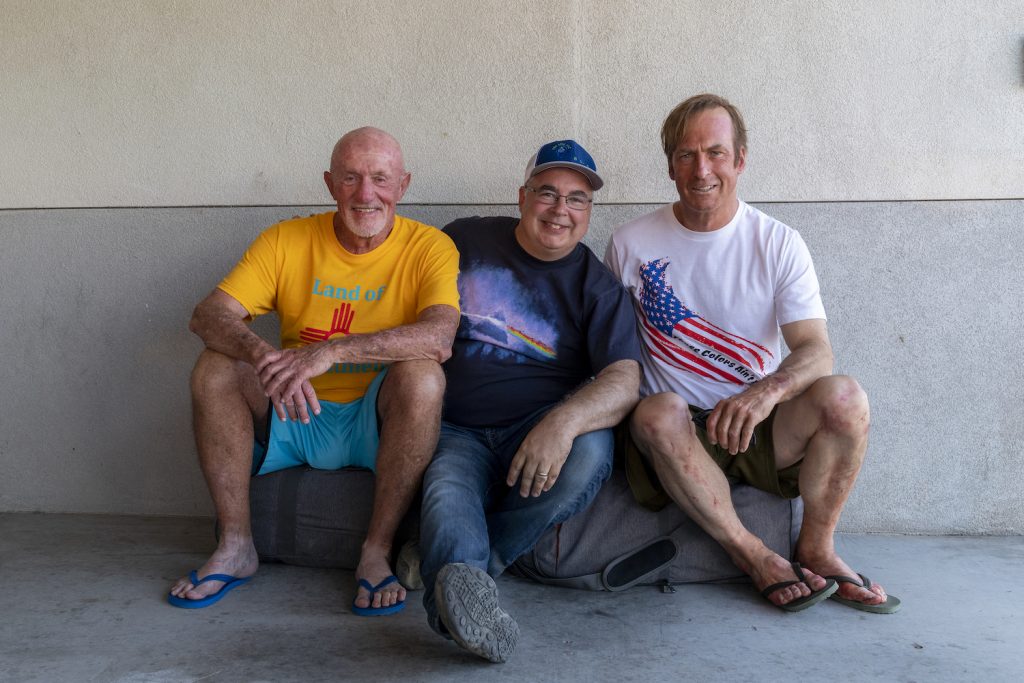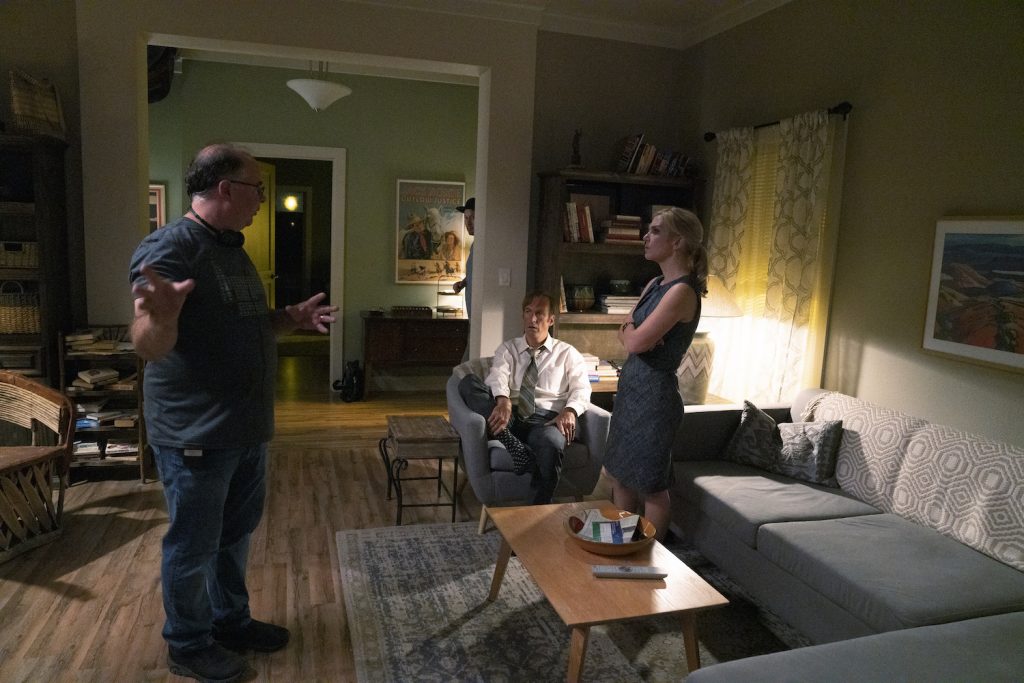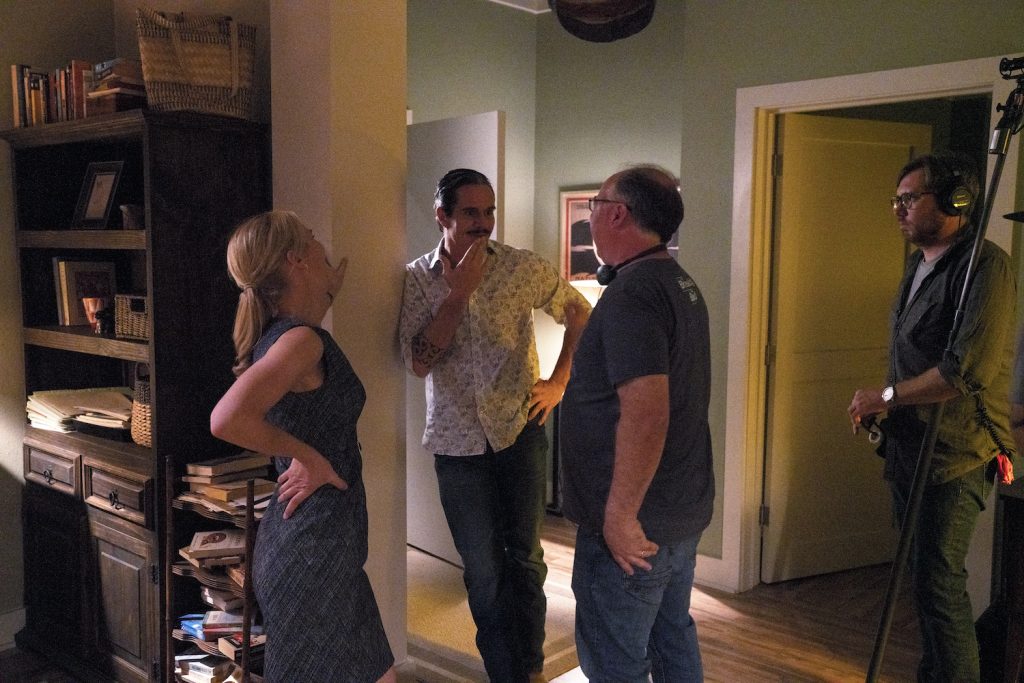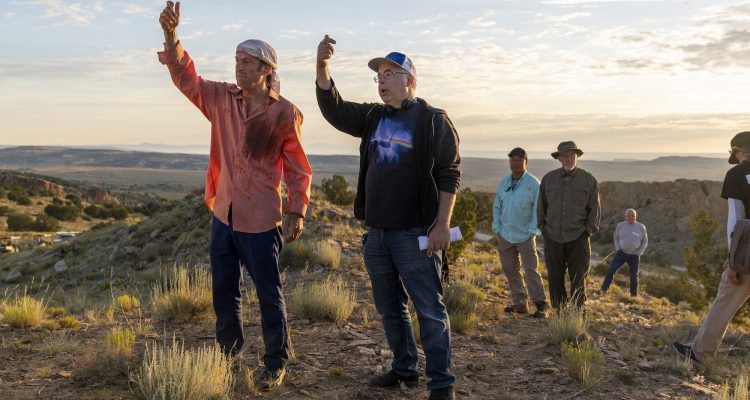Emmy winner Tom Schnauz is having a phenomenal year on AMC’s Better Call Saul. In season five of the Emmy nominated series, Jimmy McGill (Bob Odenkirk) has fully embraced his Saul Goodman persona, earning a steady supply of not-so-safe work from cartel boss Lalo Salamanca (Tony Dalton).
In episode eight, Jimmy survives a bloody desert ambush thanks to the sniper skills of Mike Ehrmantraut (Jonathan Banks). However, the trauma of the near death experience weighs heavy on McGill, along with the seven million in cash he’s lugging through the desert.
Following the grueling desert shoot with director Vince Gilligan, Schnauz picks up the reigns with episode nine, “Bad Choice Road.” The episode, which Schnauz wrote and directed, is undeniably the best episode of the season and arguably the best hour of television broadcast in 2020. Schnauz’s work puts him in a very competitive spot for two Emmy nominations thanks to the episode’s incredible character work and pulse-pounding climax.
In the climax, Schnauz’s writing shines a spotlight on the sheer talent his cast, pitting Kim Wexler (Rhea Seehorn) against armed cartel boss Lalo Salamanca. Kim initiates the face-off after watching a battle-worn and PTSD-stricken Jimmy McGill struggle with his fabricated story.
The high stakes sequence offers standout moments for all three actors, particularly four-time Emmy nominee Bob Odenkirk who shows us a vulnerability to Saul/Jimmy that we’ve yet to witness.
Schnauz spoke to Award Focus about the daunting aspects of filming the climax of “Bad Choice Road,” what he hopes to achieve with season six, and how Taxi Driver inspired one of Jimmy’s lines.
Awards Focus: Given the current limitations caused by the pandemic, how are you adjusting to the zoom writers room for the show’s final season?
Tom Schnauz: I’m grateful to be working, but zoom is a different animal for sure. There’s a certain rhythm you have when you’re with people in a room together, and on our show we put everything down on index cards then put it up on boards. It’s just so much easier, and we’ve resorted to having to raise hands to speak (laughs).
AF: Where are you in terms of mapping out the season?
Schnauz: We’re through a bunch of episodes now, we’re probably halfway through the season right now.
AF: In a previous interviews, you’ve said that you couldn’t imagine not having a full episode in the Gene storyline, and possibly additional ones. With the expanded episode count, how do you balance resolving the prequel storyline and giving fans an adequate farewell for the black and white sequel story of Gene?
Schnauz: Truthfully, we are still not there yet. We want to give the story we’ve been telling its due, and we want to figure out what happens to Gene. We will see Gene, whether it’s a full episode or doing some cutting back and forth with the timelines is the bigger question. The face-off between Gene and the taxi driver will be an interesting confrontation.
AF: Talk about your writing process on episode nine, specifically the climax where Lalo shows up to Kim and Jimmy’s apartment. Rhea Seehorn commented on how their apartment was always the safe place, and danger never came knocking until now.
Schnauz: With that episode, I took full advantage that everyone is worried about what will happen to Kim Wexler. Everyone is afraid something bad is going to happen to her, and with it being toward the end of the season it’s the right time for that to happen.
As I was writing it, I really enjoyed having Kim take a mallet to Lalo with her arguments and tenacity. I really wanted the audience to cheer her on as she did it… Rhea Seehorn just took that dialogue and made it her own in a phenomenal way.
AF: Talk about Kim’s choice to go head on with Lalo.
Schnauz: Kim has only met Lalo one time and she really steps in because she can see that Jimmy is crumbling in that moment, and whatever he’s hiding from them he’s doing it for a good reason.
AF: What’s interesting is that even before the Lalo confrontation, you have this great face-off between Jimmy and Kim. Jimmy can’t understand why Kim would leave her job and the Mesa Verde case.
Earlier in the episode, you gave Mike a great speech, which Jonathan Banks praised when we spoke, about getting on a road and that ultimately you can’t avoid where it’s taking you. It was a wonderful moment between Jimmy and Mike, but then we see Jimmy try to relay that same speech to Kim and it doesn’t quite work.
Schnauz: If you look through the series, there’s a history of Jimmy McGill copying other people’s words and take it on was his own. In this instance, he knows Mike was trying to impart some words of wisdom but he didn’t quite get the message.
It’s funny, at the end of the conversation between Jimmy and Mike, Jimmy says, “I can’t believe you’re the only person I can talk to about this.” I had rewatched Taxi Driver around the time of writing that episode and there’s a great scene in the film between Robert De Niro and Peter Boyle.
De Niro is on the side of the road talking with Boyle’s character, the wizard, and he’s saying something to try to make De Niro feel better. “Some people live, some people die….blah blah blah.” At the end of the scene, De Niro says, “That’s just about the dumbest thing I ever heard.” That was the inspiration for that moment with in Better Call Saul.

AF: Rhea Seehorn mentioned that you did the lighting and blocking for the apartment confrontation ahead of the shoot, so you could use all the time for shooting the scene. Talk about working with a tight schedule and the necessity to maximize the preparation.
Schnauz: We were able to get some time onstage on the weekend and that was a tremendous help. Tony, Rhea, and Bob agreed to come in and rehearse because there’s really not a lot of time to get these things done. I remember Marshall Adams (Director of Photography) was there and we watched the actors go through it.
Luckily, a lot of the climax takes place on the couch, because the more movement you have the more coverage you need and it takes a lot of time. In terms of specifics, Lalo at the door, the couch conversation, and the fish tank all took a day to film.
To make things even more difficult, we had a squirrel get into the transformer at the stage and it blew out our power. We had to wait about an hour to get power back.
AF: How did the squirrel look?
Schnauz: I did not get to see the squirrel, I just heard that it did not survive the encounter with the transformer.
AF: The other component to the climax is Mike on the opposing building’s rooftop with the snipe rifle aim at Lalo. Can you discuss the editing process and how you played with the intercut?
Schnauz: I had written the intercut into the script and our editor, Chris McCaleb, he did a hell of a job cutting that scene. He actually cut it at a different points, but I remember sticking with what he had done. The key was to hit the right amount of anxiety when Kim gets between Lalo and the sniper rifle. I wanted the audience to think she would accidentally take on in the back.


AF: Kim seems to be breaking bad in the finale with her seemingly cruel pitch to decimate Howard Hamlin and force a settlement on the Sandpiper case — benefitting Jimmy and the elderly residents.
When Kim has acted out previously, she’s always had an innate desire to atone or fix the action she took. When Kim and Jimmy threw the beer bottles off the balcony, she was up early the next morning and sweeping the glass. If Kim were to go through with hurting Howard, do you suspect she’d try and fix it after the fact?
Schnauz: I think at the end of the season, Kim is coming to the conclusion that they can do this to Howard and cause him a “career setback” as she calls it. That’s something we’re talking about as we break season six, how far is she willing to go? She has a Robin Hood theory in terms of Howard, and connecting Howard’s potential settlement to all the files that she saw in the courthouse basement. Those files are all people in need of better representation.
AF: We know that Jimmy is moving closer to Saul as he’s doing business with the cartel. Beyond that, Jimmy clearly desires the respect that comes from success and wealth. We hear that as he chases Howard out of the courthouse.
On the other side of that, Jimmy sees what his choices have done to Kim and it concerns him. There’s a great tension there, can you talk about how you want to exploit that going forward?
Schnauz: Is Jimmy influencing her or is some part of her just coming to life? All the way back to season one, we see her smiling at Jimmy’s billboards. When Jimmy asks, “Am I bad for you?” he truly doesn’t know. He suspects as much, but it could be more complicated than that. They may be two pieces of a puzzle that fit together very nicely but create something horrible.


